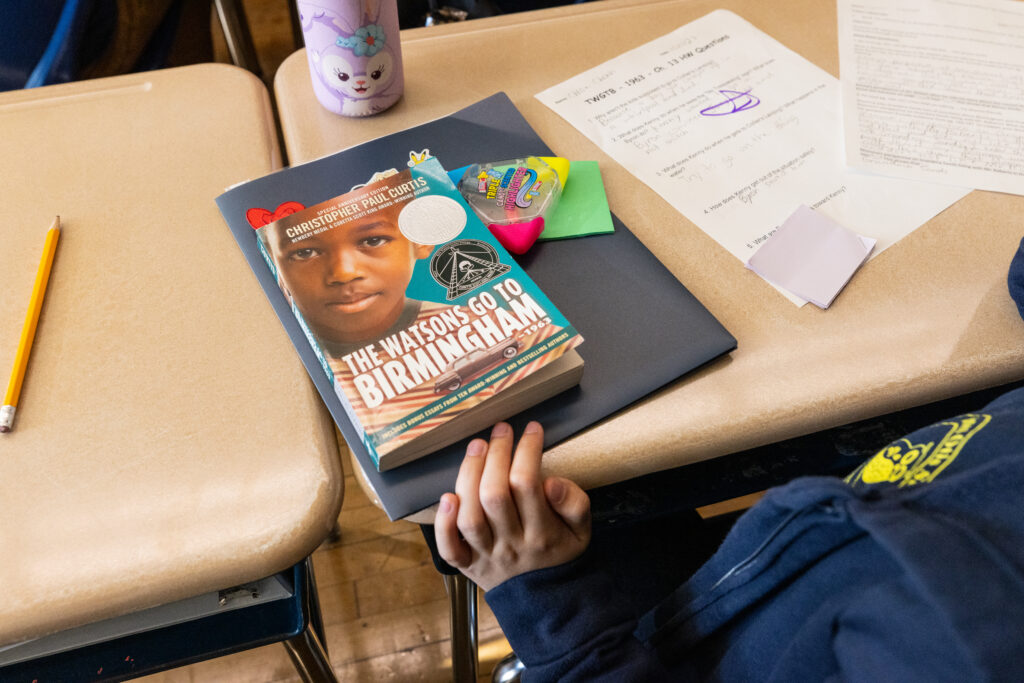‘The Watsons Go to Birmingham,’ a historical fiction novel set in 1963, builds middle-school reading skills while also teaching historical background knowledge. (Jo Sittenfeld/Rhode Island Current)
The Right to Read Act, passed in 2019, champions science-based reading instruction
The law is dense with wonky ed-jargon. But Rhode Island’s Right to Read Act actually will revolutionize the way elementary and secondary educators teach kids to read.
Realistically, only legal action has the power to turn around our education industry a full 180 degrees – statewide. Passed in 2019 and backed by mountains of research on science-based reading, Right to Read will end longstanding but terrible methods for teaching reading in Rhode Island. The law demands that public educators replace all elementary reading curricula and re-train every one of Rhode Island’s 14,339 educators in 310 schools, by 2025. It’s a gargantuan lift.
We badly need Right to Read. Two-thirds of Rhode Island’s students are already poor readers. Indeed, our vastly inflated graduation rate includes lots of kids who are functionally illiterate.
So, every K-12 educator must take one of two paths towards learning “Structured Literacy,” the name for the overall initiative. One path is “Full Proficiency,” which broadly applies to elementary teachers and anyone responsible for teaching learning-to-read skills. Elementary schools will also be the ones grappling with new curriculum. The other path is “Awareness,” for secondary educators and everyone else on staff who needs to rework the delivery of their content to shore up kids’ reading comprehension skills.
To illustrate the two paths, we turn to a visual called Scarborough’s Rope, widely considered the best way to introduce the science behind reading.
Researcher and psychologist Dr. Hollis Scarborough had long been a mainstay of the International Dyslexia Association, a group dedicated to struggling readers since the early 20th century. In 1992, her publications opened a floodgate of requests to give talks about her findings to parents of kids with reading problems and teachers trying to solve those problems.
To demonstrate the acquisition of proficient reading to a lay audience, she used eight pipe cleaners,each representing a distinct cognitive skill. As she talked, she wove the strands together according to their scientific relation to one another, until the eight separate strands braided into an image of skilled reading. The pipe cleaners became a graphic summary that visualizes the complexity of reading, and details for us the two R2R paths:
Full Proficiency: Three cool-colored strands represent skills essential to learning to read:
- Phonological Awareness – Foundational to all reading is the ability to distinguish between phonemes, which are the sounds that make up spoken speech. Say words like “purple,” “groundhog” or “station” to hear each individual sound. “Ground” is a single phoneme, however long its spelling.
- Decoding – Each phoneme has written expressions. English is a pain because phonemes like “shun” and “(sta)tion” are the same sound, but written differently. Decoding is not exclusively phonics, but also spelling and alphabetic principles like: “‘i’ before ‘e’ except after ‘c’.”
- Sight recognition – Beginning readers start by scanning easy sight words – “the,” “you,” “and” – but must constantly expand their scanning vocabulary to longer and more complex words.
Building these three skills allows us to read without stopping to unpack individual words.
The other five skills build reading comprehension and are included in Full Proficiency training. Little kids, K-5, develop their reading ability by focusing on real texts that have, say, scientific, historical or literary value as opposed to what education journalist Natalie Wexler calls a “content vacuum” where the subjects are often current celebrities or fashion fads.
For teachers of grades 6-12, the R2R law mandates a 10-hour “Awareness” course developed by the Rhode Island Department of Education (RIDE) with a research and training group, BRIDGE-RI.
Awareness: The Rope’s five warm-colored strands represent the “increasingly strategic” aspects of acquiring language comprehension. They are:
- Background knowledge – The more anyone knows about a subject, the easier it is to learn more and remember it. Everyone needs a context when studying, say, Impressionist painters. What was the relevant period of history, its fashions, the artists’ influences and who their friends were? Facts don’t live in a vacuum.
- Vocabulary – Vocabulary is strongly associated with IQ. High quality texts can actively raise IQ by expanding the volume of words a kid understands.
- Language Structure – While vocabulary is the understanding of individual words, language structure underlies whole sentences. For example, the arrangement of a sentence’s words, syntax, determines the sentence’s meaning.
- Verbal Reasoning – After reading and processing information, can the child reach a conclusion? A solution? The next step? The answer to “Why?”
- Literacy Knowledge – What genre might be best to express an idea? What literary forms are out there – graphic novel, sonnet, obituary – to guide written expression?
The thing is, any one dysfunctional strand can undercut all the others.
Right to Read mandates school communities at all levels to figure out which of those strands is holding up each struggling reader. Families can help.
You can find many of the Awareness lessons are available to the public on the “Structured Literacy” page of RIDE’s website.
In fact, I dearly hope that parents and the public get to know more about this initiative so they can support and hold accountable Right to Read’s ambitious objectives. Some districts and stand-alone schools are already deep into the work and showing exciting results in their internal assessments of student achievement. We don’t want to lose the momentum the law has already generated.
Right to Read offers our best shot at radically improving the overall quality of Rhode Island’s lackluster education system.
First published: RI Current News, January 22, 2024
Public comments posted on this site are much appreciated. However, if you prefer: [email protected]
